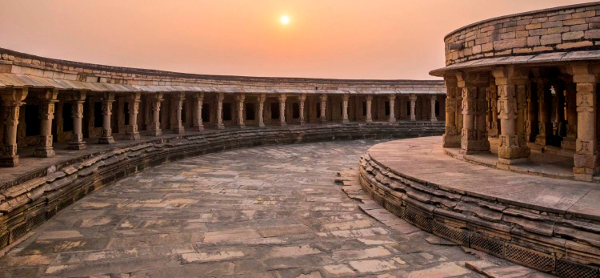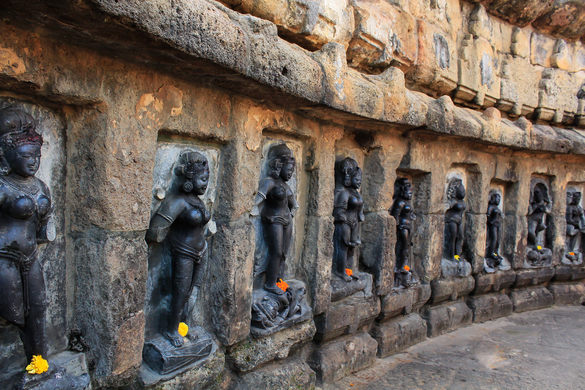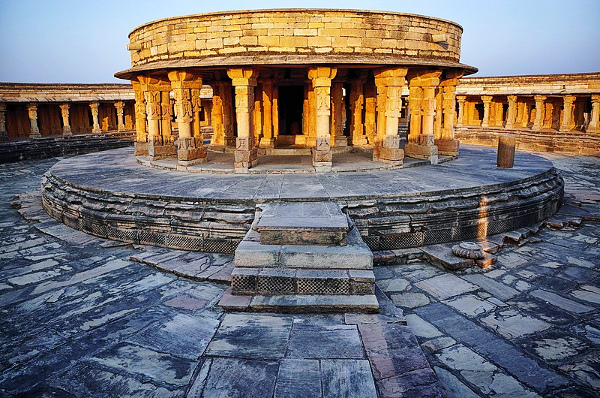The temple of Chauhaath Yogini (which resembles the Parliament building itself), also known as Ektto Mahadev Temple, is an 11th Century temple located in the Murena district of the Indian state of Madhya Pradesh. It is one of the elite temples of the country which is in good condition. The temple is made of a circular wall, which has 64 rooms and there is a pavilion in the middle center, which is separate from a courtyard, which is circular in shape, where Lord Shiva has been restored. This temple has been declared an ancient historical monument by the Archaeological Survey of India.

Who is Yogini’s
The women who decorated with jewelry used to dance themselves in the Hindu temples, dance in the temples and sang songs in the temples and loved the Gods, but love is spiritual. We can assume that the way to get God to him would have been a little different, in which there would have been a way to find God, but by not denying the beauty of life.
What is Yogini Temple
A lot of pictures in the Hirapura Yogini temple show the ladies in different postures. Some dance, some people with bow and trident, while making some music, drinking some alcohol, and sharing some household chores. Most women are dressed up with fine hairstyles. Others have a snake, or bear, or a lion, or elephant head. They are standing on camels, human heads, male bodies, crows, roasters, peacocks, bulls, buffaloes, asses, swine, scorpions, crabs. No such thing has been found in the Murena temple. Maybe with the time, they have been removed from the temple.
History
According to an inscription, the temple was constructed in 1323 AD by Kuchpaghat King Devpal. It is said that the temple was the place to provide education in astrology and mathematics on the basis of the Sun’s transit.
Why was the name of the temple named Chaushat Yogini

Why only sixty-nine? There is no clear answer to this. It may be that it refers to the sixty-four arts, or the sixty-four apsarao (Apsara is the most beautiful divine woman in God’s land. Thye live with God not with humans). It is possible that the meaning is very much cryptic, mentioning eight divisions of time which make up one or eight directions or box of the chess board
Other Yogini Temples
However, the Jyottar Yogini temple has been destroyed but some are still left. There are two in Odisha, Bhubaneswar near Bolpur in and Hirapur near Ranipur. In Madhya Pradesh, there are three non-secricular ruins Bhedaghat near Jabalpur, in Mithauli in Murena district, and in Khajuraho.
- Chausath Yogini Temple Jabalpur
- Chausatha Yogini Mandir Hirapur
- Chaushath Yogini Temple Khajuraho
What is special?
It is believed that the British architect who built the Indian Parliament House had taken inspiration from the Chaushat Yogini Temple Murena. But there is no evidence available for this. The structure of the temple has been done in such a way that it can be resistant to earthquake and the earthquake tremors because of Chauhta Yogini temple in the highly sensible earthquake area. To collect water, one of the main drains goes to the temple storage area, so that the water can be collected.
Source: Thathasthu
Image Courtesy: Astrological World Map
You may also like
-
India Can’t Afford to Remain Stagnant at this Juncture, Says PM Modi; Asks People to Buy Locally-Made Goods
-
Stolen Artefacts to be Returned to India from Scotland Museums
-
Netaji’s Hologram Statue at India Gate
-
10th Century Stone Idol of Goat Head Yogini IllegallyRemoved from A Temple in Lokhari, Banda, UP Being Returned to India
-
UNESCO Inscribes ‘Durga Puja in Kolkata’ on the Representative List of Intangible Cultural Heritage of Humanity
